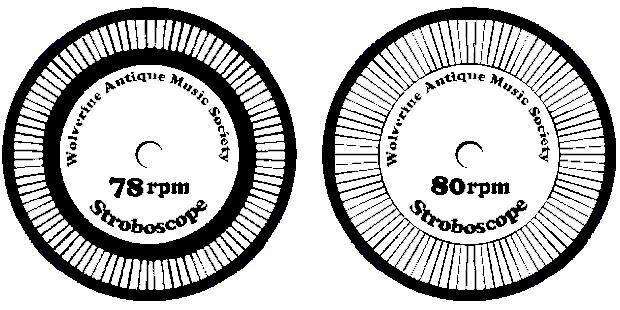A stroboscope for phonographs consists of a circle of equally spaced lines on a contrasting background, for example black on white. When the stroboscope is viewed under an electric light powered by alternating current electricity, (at 60 cycles!) the little lines appear to stand still when the turntable is rotating at the proper speed.What happens is, the electric light is actually blinking on and off 3600 times a minute and each time the light goes on, the black lines on the stroboscope have rotated one space if the stroboscope is running at the proper speed. The proper speed is determined by the number of lines in the circle. If you want to make a stroboscope which indicates 78 RPM, take 7200 (2x3600) and divide it by 78. That gives you the number 92.3. If you round down to 92, and mark 92 equally spaced lines around the circumference of a circle, you will have made a stroboscope which indicates a speed of 78.26, which is close enough for most purposes. Conversely, an 80 RPM stroboscope would be 7200 divided by 80, or 90 lines. After the twenties, most everyone standardized on 78, but before that the speeds fluctuated quite a bit from label to label, and even on the same label. Early Victors were set to 71 RPM until the teens, and Edison's vertically-cut diamond disks were always recorded at 80, as were most of the early 20s Brunswicks. In the W.A.M.S. file, STROBE.ZIP, you will find the images below as two uncompressed Tagged Image Format files, (.TIFs). To use them, you must first print the files, (WSRB78.TIF and WSRB80.TIF) onto paper. These images have been scaled to be 3.5 inches square when printed on a 300 dpi laser printer. While a dot-matrix printer may well print these dudes out, the low resolution may obscure the lines, rendering this technique useless. So a laser printer (or InkJet/BubbleJet) would be the best bet. Some print shops like Kinkos have Laser printer output services from disk file for a buck or two a sheet. I printed mine out of PageMaker 4.0 with 6 stroboscopes per 8.5 by 11 inch Avery laser printer one-sheet sticky-label material. Then I cut out the images, and stick them either onto a piece of cardboard, or better yet, an old record, (you know, those ones that are SO scratchy, they sound like bacon frying!). This way, you can stick the 78 one on side A, and the 80 on side B. Needless to say, these Stroboscopes are good ONLY in areas served by 60 Hz power, such as the U.S. and Canada. 50 Hz folks overseas will have to use disks scaled for their power systems. The information on how the stroboscopes work I got out of the excellent book "The Complete Talking Machine: A Collector's Guide to Antique Phonographs" by Eric L. Reiss; pages 222-223 (Second Edition - 1996; Sonoran Publishing LLC, Chandler, AZ - ISBN 1-886606-08-0). I highly recommend this guide to any and all who are interested in sound reproduction and restoration of antique acoustic phonographics. And for making strobe disks of other speeds, I urge you to check out Adrian Hindle-Briscall's amazing MS-DOS program that will automatically create strobe disks for most any speed and(or) power cycle. It is available for download from Kurt Nauck's "Turntable Stroboscope Disc" page at: http://www.infohwy.com/~nauck/turntables/Strobe.htm. Check it out, as well as the rest of Kurt's cool site for more antique phonographic information, supplies and original recordings!
For Windows 95 users, download the file "Strobo" from here. This cool "swissmade programme" is freeware and was created by J. Vernet Morges of Switzerland. It is provided here by way of a special agreement with the author. This ZIPped archive is only 83 kB in size, but offers a quick and easy way to create strobe disks for any speed and in either 50 or 60Hz! Highly recommended!
|

